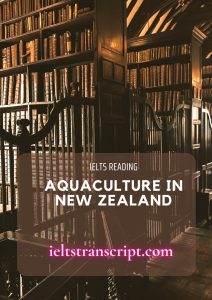- Đối với sản phẩm có giá: Sau khi chúng tôi ghi nhận thông tin đã thanh toán sản phẩm của bạn, sản phẩm sẽ được mở khóa và bạn có thể xem trực tiếp và tải tài liệu sản phẩm.
- Đối với thành viên trả phí: Bạn có thể mua và thanh toán sản phẩm với giá 0đ để tải tài liệu sản phẩm.
- Bạn có thể liên hệ với chúng tôi để được hỗ trợ mở khóa sản phẩm sớm nhất.
Aquaculture in New Zealand
- Chúng tôi chấp nhận các phương thức thanh toán sau đây: Thẻ tín dụng, thẻ ghi nợ, PayPal, chuyển khoản ngân hàng và tiền mặt.
Chúng tôi sẽ không thu thêm phí cho bất kỳ hình thức thanh toán nào.
- Nếu bạn gặp vấn đề về sản phẩm của chúng tôi trong thời gian sử dụng, vui lòng liên hệ với chúng tôi để được hỗ trợ xử lý sớm nhất nhé.
Xem trước mẫu
Aquaculture in New Zealand
A The world’s first wild algae biodiesel, produced in New Zealand by Aquaflow Bionomic Corporation, was successfully test driven in Wellington by the Minister for Energy and Climate Change Issues, David Parker. In front of a crowd of invited guests, media and members of the public, the Minister filled up a diesel-powered Land Rover with Aquaflow B5 blend bio-diesel and then drove the car around the forecourt of Parliament Buildings in Central Wellington. Green Party co-leader, Jeanette Fitzsimons was also on board. Marlborough-based Aquaflow announced in May 2006 that it had produced the world’s first bio-diesel derived from wild microalgae sourced from local sewage ponds.
B “We believe we are the first company in the world to test drive a car powered by wild algae-based biodiesel. This will come as a surprise to some international bio-diesel industry people who believe that this break-through is still years away,” explained by Aquaflow spokesperson Barrie Leay. “A bunch of inventive Kiwis, and an Aussie, have developed this fuel in just over a year “, he comments.” This is a huge opportunity for New Zealand and a great credit to the team of people who saw the potential in this technology from day one.”
C Bio-diesel based on algae could eventually become a sustainable, low cost, cleaner burning fuel alternative for New Zealand, powering family cars, trucks, buses and boats. It can also be used for other purposes such as heating or distributed electricity generation. There is now a global demand for billions of litres of biodiesel per year. Algae are also readily available and produced in huge volumes in nutrient rich waste streams such as at the settling ponds of Effluent Management Systems (EMS). It is a renewable indigenous resource ideally suited to the production of fuel and other useful by-products. The breakthrough comes after technology start-up, Aquaflow, agreed to undertake a pilot with Marlborough District Council late last year to extract algae from the settling ponds of its EMS based in Blenheim. By removing the main contaminant to use as a fuel feedstock, Aquaflow is also helping clean up the council’s water discharge – a process known as bio-remediation. Dairy farmers and many food processors too, can benefit in similar ways by applying the harvesting technology to their nutrient- rich waste streams.
D Blended with conventional mineral diesel, bio-diesel can run vehicles without the need for vehicle modifications. Fuel derived from algae can also help meet the Government B5 (5% blended) target, with the prospect of this increasing over time as bio-fuel production increases. “Our next step is to increase capacity to produce one million litres of bio-diesel from the Marlborough sewerage ponds over the next year,” says Leay. Aquaflow will launch a prospectus pre-Christmas as the company has already attracted considerable interest from potential investors. The test drive bio-diesel was used successfully in a static engine test at Massey University’s Wellington campus on Monday, December 11.
E Today Algae are used by humans in many ways; for example, as fertilizers, soil conditioners and livestock feed. Aquatic and microscopic species are cultured in clear tanks or ponds and are either harvested or used to treat effluents pumped through the ponds. Algaculture on a large scale is an important type of aquaculture in some places. Naturally growing seaweeds are an important source of food, especially in Asia. They provide many vitamins including: A, B, B2, B6, niacin and C, and are rich in iodine, potassium, iron, magnesium and caicium. In addition commercially cultivated microalgae, including both Algae and Cyan-bacteria, are marketed as nutritional supplements, such as Spirulina, Chlorella and the Vitamin-C supplement. Dunaliella, high in beta-carotene. Algae are national foods of many nations: China consumes more than 70 species, including fat choy, a
...Nuôi trồng thủy sản ở New Zealand
A Dầu diesel sinh học từ tảo hoang đầu tiên trên thế giới, được sản xuất tại New Zealand bởi công ty Aquaflow Bionomic, đã được Bộ trưởng Bộ Năng lượng và Các vấn đề Biến đổi Khí hậu, David Parker, thử nghiệm thành công ở Wellington. Trước sự chứng kiến của đông đảo các vị khách mời, giới truyền thông và công chúng, Bộ trưởng đã đổ đầy bình một chiếc Land Rover chạy bằng động cơ diesel với hỗn hợp diesel sinh học Aquaflow B5 và sau đó điều khiển xe chạy vòng quanh khu vực tiền sảnh của Tòa nhà Quốc hội ở Trung tâm Wellington. Đồng lãnh đạo Đảng Xanh, Jeanette Fitzsimons cũng có mặt ở đó. Công ty Aquaflow có trụ sở tại Marlborough thông báo vào tháng 5 năm 2006 rằng họ đã sản xuất dầu diesel sinh học đầu tiên trên thế giới có nguồn gốc từ vi tảo hoang lấy từ các ao nước thải địa phương.
B “Chúng tôi tin rằng chúng tôi là công ty đầu tiên trên thế giới thử một chiếc ô tô chạy bằng dầu diesel sinh học từ tảo hoang. Điều này sẽ gây ngạc nhiên cho một số người làm trong ngành công nghiệp diesel sinh học quốc tế, những người tin rằng sự đột phá này nhiều năm nữa mới xuất hiện, ”người phát ngôn của Aquaflow, Barrie Leay giải thích. Ông bình luận: “Nhiều người New Zeadland và người Úc có nhiều sáng chế đã phát triển loại nhiên liệu này chỉ trong hơn một năm”. Đây là một cơ hội lớn cho New Zealand và là một sự tín nhiệm lớn đối với đội ngũ những người đã nhìn thấy tiềm năng của công nghệ này ngay từ ngày đầu tiên.”
C Diesel sinh học làm từ tảo, cuối cùng có thể trở thành một giải pháp thay thế nhiên liệu đốt sạch hơn, chi phí thấp, bền vững cho New Zealand, cung cấp năng lượng cho ô tô gia đình, xe tải, xe buýt và tàu thuyền. Nó cũng có thể được sử dụng cho các mục đích khác như sưởi ấm hoặc phát điện phân phối. Hiện trên toàn cầu cần hàng tỷ lít diesel sinh học mỗi năm. Tảo cũng có sẵn và được sản sinh với khối lượng lớn trong các dòng chất thải giàu dinh dưỡng như tại các ao lắng của Hệ thống Quản lý Nước thải (EMS). Đây là một nguồn tài nguyên bản địa có thể tái tạo được, lý tưởng cho việc sản xuất nhiên liệu và các sản phẩm phụ hữu ích khác. Bước đột phá xuất hiện sau khi công ty khởi nghiệp công nghệ, Aquaflow, đồng ý thực hiện thí điểm với Hội đồng Quận Marlborough vào cuối năm ngoái để tách tảo từ các ao lắng của EMS tại Blenheim. Bằng cách loại bỏ chất gây ô nhiễm chính để làm nguồn cung cấp nhiên liệu, Aquaflow cũng đang giúp làm sạch nước xả của hội đồng – một quá trình được gọi là xử lý sinh học. Nông dân chăn nuôi bò sữa và nhiều nhà chế biến thực phẩm cũng có thể hưởng lợi theo những cách tương tự bằng cách áp dụng công nghệ thu hoạch vào các dòng chất thải giàu dinh dưỡng của họ.
D Được pha trộn với dầu diesel khoáng thông thường, diesel sinh học có thể làm phương tiện chạy mà không cần phải chuyển sang phương tiện khác. Nhiên liệu có nguồn gốc từ tảo cũng có thể góp phần vào việc đạt được mục tiêu B5 (5% pha trộn) của Chính phủ, với triển vọng tăng theo thời gian khi sản lượng nhiên liệu sinh học tăng lên. Leay cho biết: “Bước tiếp theo của chúng tôi là tăng công suất sản xuất một triệu lít diesel sinh học từ các ao thoát nước ở Marlborough trong năm tới.” Aquaflow sẽ tung ra bản cáo bạch trước Giáng sinh vì công ty đã thu hút được sự quan tâm đáng kể từ các nhà đầu tư tiềm năng. Dầu diesel sinh học đã được sử dụng thành công với động cơ thử nghiệm tĩnh tại khuôn viên Wellington của Đại học Massey vào thứ Hai, ngày 11 tháng 12.
E Ngày nay Tảo được con người sử dụng theo nhiều cách; ví dụ, như phân bón, chất điều tiết đất và thức ăn chăn nuôi. Các loài thủy sinh và các loài siêu nhỏ được nuôi trong các bể hoặc ao trong và được thu hoạch hoặc sử dụng để xử lý nước thải bơm qua ao. Nuôi trồng thủy sản quy mô lớn là một loại hình quan trọng ở một số nơi. Tảo biển mọc tự nhiên là một nguồn thực phẩm quan trọng, đặc biệt là ở châu Á. Tảo cung cấp nhiều loại vitamin bao gồm: A, B, B2, B6, niacin và C, và rất giàu iốt, kali, sắt,
...Để xem được đầy đủ nội dung và tải dữ liệu, bạn phải trở thành thành viên của chúng tôi và trả phí cho tài liệu (nếu có)











